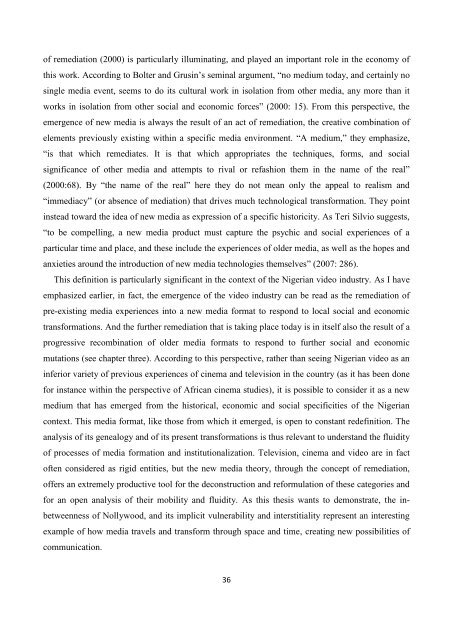Create successful ePaper yourself
Turn your PDF publications into a flip-book with our unique Google optimized e-Paper software.
of remediation (2000) is particularly illuminating, and played an important role in the economy ofthis work. According to Bolter and Grusin’s seminal argument, “no medium today, and certainly nosingle media event, seems to do its cultural work in isolation from other media, any more than itworks in isolation from other social and economic forces” (2000: 15). From this perspective, theemergence of new media is always the result of an act of remediation, the creative combination ofelements previously existing within a specific media environment. “A medium,” they emphasize,“is that which remediates. It is that which appropriates the techniques, forms, and socialsignificance of other media and attempts to rival or refashion them in the name of the real”(2000:68). By “the name of the real” here they do not mean only the appeal to realism and“immediacy” (or absence of mediation) that drives much technological transformation. They pointinstead toward the idea of new media as expression of a specific historicity. As Teri Silvio suggests,“to be compelling, a new media product must capture the psychic and social experiences of aparticular time and place, and these include the experiences of older media, as well as the hopes andanxieties around the introduction of new media technologies themselves” (2007: 286).This definition is particularly significant in the context of the Nigerian video industry. As I haveemphasized earlier, in fact, the emergence of the video industry can be read as the remediation ofpre-existing media experiences into a new media format to respond to local social and economictransformations. And the further remediation that is taking place today is in itself also the result of aprogressive recombination of older media formats to respond to further social and economicmutations (see chapter three). According to this perspective, rather than seeing Nigerian video as aninferior variety of previous experiences of cinema and television in the country (as it has been donefor instance within the perspective of African cinema studies), it is possible to consider it as a newmedium that has emerged from the historical, economic and social specificities of the Nigeriancontext. This media format, like those from which it emerged, is open to constant redefinition. Theanalysis of its genealogy and of its present transformations is thus relevant to understand the fluidityof processes of media formation and institutionalization. Television, cinema and video are in factoften considered as rigid entities, but the new media theory, through the concept of remediation,offers an extremely productive tool for the deconstruction and reformulation of these categories andfor an open analysis of their mobility and fluidity. As this thesis wants to demonstrate, the inbetweennessof Nollywood, and its implicit vulnerability and interstitiality represent an interestingexample of how media travels and transform through space and time, creating new possibilities ofcommunication.36
















